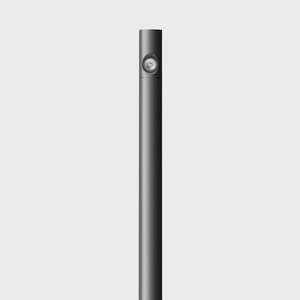Rury elementów oświetleniowych z reflektorami
Rury elementów oświetleniowych z aluminium, z jednym wbudowanym reflektorem. Reflektor z możliwością regulacji kąta nachylenia w zakresie ± 30° i obracania w zakresie 360° uzupełnia systemowy element oświetleniowy o dodatkową funkcję oświetlania na przykład detali architektonicznych, drzew i tablic informacyjnych.
Dane techniczne
Nasze rury elementów oświetleniowych dostarczamy do wyboru z podstawą lub modułem ziemnym.
Pedestrians and cyclists, as well as the walkways or cycle paths, must be easy to detect visually. Good visibility of faces conveys a feeling of safety. The degree of illuminance for paths used by cyclists and pedestrians must comply with the standard DIN EN 13201-2, illumination class P4. A minimum of 1 lx is required. The average degree of illuminance is 5 lx. Pole-top luminaires with asymmetrical flat beam light distribution are used for illumination purposes. The mounting height is 5 m. The luminaire spacing is 30 m.
Pedestrians and cyclists, as well as the walkways or cycle paths, must be easy to detect visually. Good visibility of faces conveys a feeling of safety. The degree of illuminance for paths used by cyclists and pedestrians must comply with the standard DIN EN 13201-2, illumination class P4. A minimum of 1 lx is required. The average degree of illuminance is 5 lx. Pole-top luminaires with asymmetrical flat beam light distribution are used for illumination purposes. The mounting height is 5 m. The luminaire spacing is 30 m. Pedestrians and cyclists, as well as the walkways or cycle paths, must be easy to detect visually. Good visibility of faces conveys a feeling of safety. The degree of illuminance for paths used by cyclists and pedestrians must comply with the standard DIN EN 13201-2, illumination class P4. A minimum of 1 lx is required. The average degree of illuminance is 5 lx. Pole-top luminaires with asymmetrical flat beam light distribution are used for illumination purposes. The mounting height is 5 m. The luminaire spacing is 30 m.
Pedestrians and cyclists, as well as the walkways or cycle paths, must be easy to detect visually. Good visibility of faces conveys a feeling of safety. The degree of illuminance for paths used by cyclists and pedestrians must comply with the standard DIN EN 13201-2, illumination class P4. A minimum of 1 lx is required. The average degree of illuminance is 5 lx. Pole-top luminaires with asymmetrical flat beam light distribution are used for illumination purposes. The mounting height is 5 m. The luminaire spacing is 30 m. Pedestrians and cyclists, as well as the walkways or cycle paths, must be easy to detect visually. Good visibility of faces conveys a feeling of safety. The degree of illuminance for paths used by cyclists and pedestrians must comply with the standard DIN EN 13201-2, illumination class P4. A minimum of 1 lx is required. The average degree of illuminance is 5 lx. Pole-top luminaires with asymmetrical flat beam light distribution are used for illumination purposes. The mounting height is 5 m. The luminaire spacing is 30 m. Pedestrians and cyclists, as well as the walkways or cycle paths, must be easy to detect visually. Good visibility of faces conveys a feeling of safety. The degree of illuminance for paths used by cyclists and pedestrians must comply with the standard DIN EN 13201-2, illumination class P4. A minimum of 1 lx is required. The average degree of illuminance is 5 lx. Pole-top luminaires with asymmetrical flat beam light distribution are used for illumination purposes. The mounting height is 5 m. The luminaire spacing is 30 m. Pedestrians and cyclists, as well as the walkways or cycle paths, must be easy to detect visually. Good visibility of faces conveys a feeling of safety. The degree of illuminance for paths used by cyclists and pedestrians must comply with the standard DIN EN 13201-2, illumination class P4. A minimum of 1 lx is required. The average degree of illuminance is 5 lx. Pole-top luminaires with asymmetrical flat beam light distribution are used for illumination purposes. The mounting height is 5 m. The luminaire spacing is 30 m. Pedestrians and cyclists, as well as the walkways or cycle paths, must be easy to detect visually. Good visibility of faces conveys a feeling of safety. The degree of illuminance for paths used by cyclists and pedestrians must comply with the standard DIN EN 13201-2, illumination class P4. A minimum of 1 lx is required. The average degree of illuminance is 5 lx. Pole-top luminaires with asymmetrical flat beam light distribution are used for illumination purposes. The mounting height is 5 m. The luminaire spacing is 30 m. · Pedestrians and cyclists, as well as the walkways or cycle paths, must be easy to detect visually. Good visibility of faces conveys a feeling of safety. The degree of illuminance for paths used by cyclists and pedestrians must comply with the standard DIN EN 13201-2, illumination class P4. A minimum of 1 lx is required. The average degree of illuminance is 5 lx. Pole-top luminaires with asymmetrical flat beam light distribution are used for illumination purposes. The mounting height is 5 m. The luminaire spacing is 30 m.
Pedestrians and cyclists, as well as the walkways or cycle paths, must be easy to detect visually. Good visibility of faces conveys a feeling of safety. The degree of illuminance for paths used by cyclists and pedestrians must comply with the standard DIN EN 13201-2, illumination class P4. A minimum of 1 lx is required. The average degree of illuminance is 5 lx. Pole-top luminaires with asymmetrical flat beam light distribution are used for illumination purposes. The mounting height is 5 m. The luminaire spacing is 30 m.
Pedestrians and cyclists, as well as the walkways or cycle paths, must be easy to detect visually. Good visibility of faces conveys a feeling of safety. The degree of illuminance for paths used by cyclists and pedestrians must comply with the standard DIN EN 13201-2, illumination class P4. A minimum of 1 lx is required. The average degree of illuminance is 5 lx. Pole-top luminaires with asymmetrical flat beam light distribution are used for illumination purposes. The mounting height is 5 m. The luminaire spacing is 30 m. 71 084






